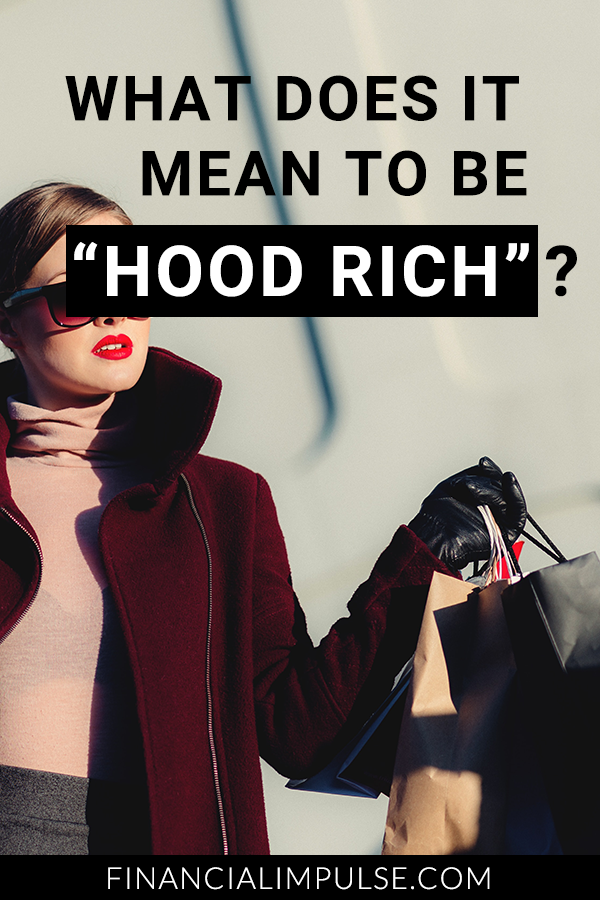Like it or not, money is inextricably tied to our emotions, particularly feelings of worth and esteem.
Ever hear the term “hood rich”?
(Image credit: Online Slang Dictionary)

It’s a slang term that rose through music and pop culture to describe a particular spending lifestyle. Specifically, “hood rich” describes people who spend beyond their means, with an emphasis on buying luxury items and status symbols even when it conflicts with their finances.
To be called hood rich generally carries a negative connotation, as this phrase highlights the difference between what one can buy and what one should buy.
To some, it may seem obvious. Don’t buy X and Y if you can only afford Z.
But following financial advice is generally far easier said than done, especially given the social meaning and value attached to certain purchases.
To get a better understanding of how this pattern of spending might appear, take a look at these real-life examples.
Examples of a Hood Rich Spending Pattern
A nationwide study conducted by Visa found that low-income families planned on spending, on average, nearly $600 more on prom than wealthier families.
| Planned Spending for Prom | |
| Household Income < $25,000 | $1,393 |
| Household Income > $50,000 | $799 |
| Average Across All Households | $919 |
In fact, the $1,393 that low-income families anticipated spending on prom amounted to roughly 5% of their total annual income. It even exceeded the average amount ($919) that all of those surveyed planned on spending.
But it’s not just prom—other research shows that low-income Americans spend a little more than two months’ wages on engagement rings on average. Meanwhile, those earning more than $23,000 a year tend to spend roughly two weeks’ worth of their income.
(Image credit: New York Times)
Although just two examples, both reflect a similar pattern: individuals spending a disproportionately large amount of their earnings on expenses that can objectively be classified as wants rather than needs. Moreover, the expenses in question—prom and wedding engagements—are social symbols that, one may argue, do not serve a functional purpose outside of beauty and appearance.
After all, you won’t be in any trouble if you decide to forego a limo for prom or choose a more affordable engagement ring. But non-negotiable expenses like rent or healthcare—that’s another story.
What’s the significance of this?
The very fact that “hood rich” exists as a term to describe indulgent spending on certain luxuries indicates that it’s not some unique one-off case; it’s a larger phenomenon that isn’t limited to high school prom or engagement rings.
From a broader standpoint, being “hood rich” reflects how the desire for social status impacts how we spend our money.
Like it or not, money is inextricably tied to our emotions, particularly feelings of worth and esteem.
It’s nearly impossible to disentangle that, especially when it’s human nature to compare your circumstances with others’. In fact, a review of past social research suggests that the desire for social status is innate. We can’t help it.
Even high-status and wealthy people are guilty of misrepresenting their lifestyles for status. In fact, on MTV Cribs, the popular show giving glimpses into celebrity lives, famous people like 50 Cent, JoJo, and Bow Wow falsely claimed to own homes and items that they actually rented.
Unfortunately, our desire for social approval—to be perceived as “cool” or “trendy”—can have devastating financial consequences. Namely, poor spending decisions.
Take, for example, Lissette Calveiro, who openly shared about how trying to curate a perfect life on Instagram landed her $10,000 in debt.

Calveiro spent an exorbitant amount on clothing and accessories “so she wouldn’t be seen on Instagram wearing the same outfit twice.” On top of that, she spent excessively on travel for the sake of looking “like a jet-setter” and collecting Snapchat geofilters.
It’s fair to say that Calveiro’s story is on the extreme side, but there’s something familiar about her desire to “take the perfect ’gram.” As a social network based on visuals, Instagram is ranked as the worst platform for mental health, with a reputation for fueling a “compare and despair” mindset among users. It feeds our very human desire for higher social status, encouraging us to spend extravagantly to attain it.
What Being Hood Rich is Not
In looking at the aforementioned examples, it’s important to note that being low-income does not equate to being hood rich. While comparisons of high- and low-income households show some broader trends in spending, they cannot and should not be generalized across all low-income families and individuals.
Moreover, it’s important to distinguish the difference between being hood rich and experiencing lifestyle creep.
What’s the difference?
Lifestyle creep generally describes an increase in spending that correlates with an increase in earning.
Hood rich spending, on the other hand, is not associated with any rise in income or wealth. The examples discussed above more closely demonstrate emotional spending, wherein someone might spend money impulsively based on their emotions rather than on logic or reason.
Lessons from the Hood Rich
There are plenty of lessons to draw from observing the hood rich. Perhaps most obvious is this:
Stop caring about what others think.
But, as with many pieces of advice, this is much harder in practice. Not to mention, it sounds preachy and over-simplistic—after all, it’s inevitable that you’ll care about what others think, even if to just a small degree.
So what can you do to avoid a hood rich lifestyle?
In short, try to think in more practical terms. Though it’s difficult to shut off your desire to look good and impress others, you can at least rein yourself from indulging in unnecessarily extravagant purchases.
For instance, when you find yourself about to buy something out of your budget, consider:
- What is the purpose of this?
- How often do you reasonably expect to use it?
- Is it a need or a want?
- Are you trying to impress someone by buying this?
- Is there a more affordable option that can serve you just as well?
Make your money work for you instead—save for retirement, pay off your debt, or invest. Buying into status symbols will only go so far in quenching your desire for social approval. For better or worse, there will always be another new luxury, another high-priced novelty item to chase.






Fascinating article. I love your four questions for reflection at the end.
I’ve never stopped to reflect on this concept before. (Those prom stats are scary.)
I feel upset for people when they drive their well being into the ground to impress others. I’ve been guilty of this in other ways (even if I’m good at being frugal), so I totally have sympathy and hope education and self-awareness can become the path to true wealth.
Yes! I think cognizance of this kind of spending is difficult to achieve since it’s so natural to want to be perceived positively. I’m thinking of all kinds of occasions that people typically want to look nice for: starting a new job, going on a date, meeting in-laws, even going to church, and so on. It can be extraordinarily easy to keep spending when you feel like you have a worthy justification.